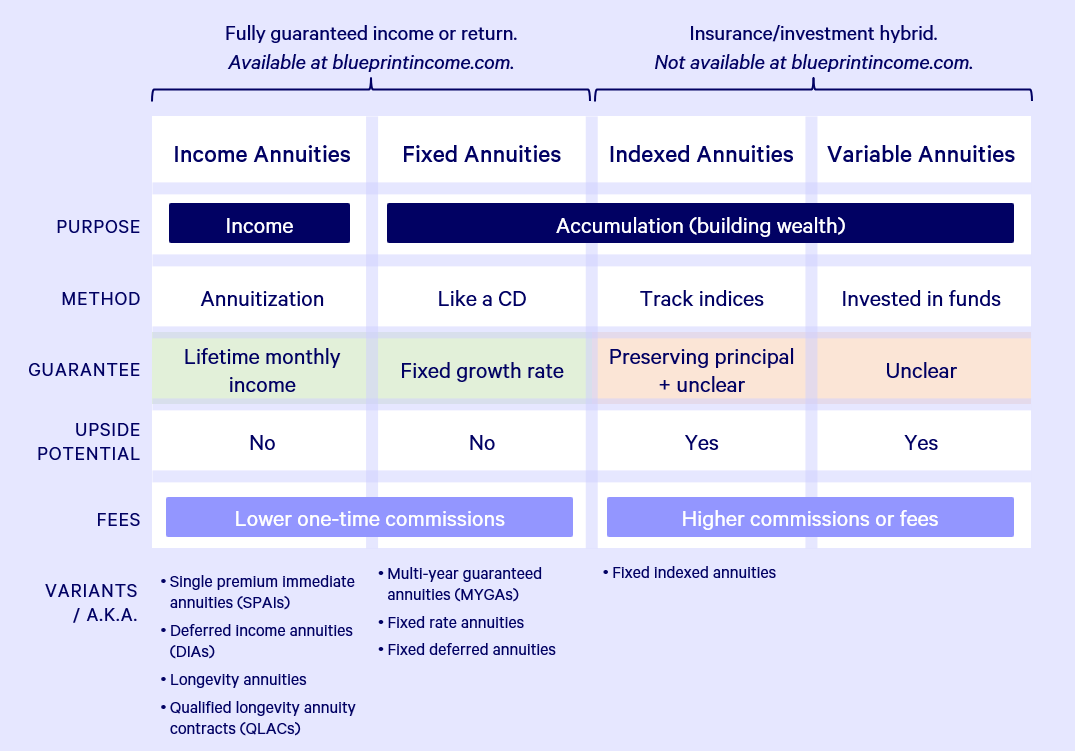All Categories
Featured
Table of Contents
The repayment could be invested for development for a lengthy duration of timea single premium delayed annuityor invested momentarily, after which payment beginsa single premium immediate annuity. Single costs annuities are usually funded by rollovers or from the sale of an appreciated property. An adaptable costs annuity is an annuity that is intended to be moneyed by a collection of payments.
Proprietors of taken care of annuities understand at the time of their purchase what the worth of the future capital will be that are generated by the annuity. Undoubtedly, the number of capital can not be recognized in advance (as this relies on the contract proprietor's life-span), but the assured, fixed interest rate at least provides the owner some level of assurance of future revenue from the annuity.
While this distinction appears basic and straightforward, it can dramatically impact the value that an agreement proprietor eventually originates from his or her annuity, and it creates significant uncertainty for the contract owner - Fixed annuities vs market risk. It additionally typically has a product influence on the level of charges that a contract proprietor pays to the issuing insurance provider
Fixed annuities are often made use of by older capitalists who have actually limited properties yet who wish to offset the risk of outliving their possessions. Fixed annuities can work as an effective device for this purpose, though not without specific drawbacks. In the instance of prompt annuities, once a contract has been acquired, the contract owner relinquishes any and all control over the annuity properties.
Understanding Variable Vs Fixed Annuity A Comprehensive Guide to Indexed Annuity Vs Fixed Annuity Defining the Right Financial Strategy Benefits of Choosing the Right Financial Plan Why Fixed Vs Variable Annuities Is Worth Considering What Is A Variable Annuity Vs A Fixed Annuity: How It Works Key Differences Between Variable Annuity Vs Fixed Indexed Annuity Understanding the Risks of Fixed Indexed Annuity Vs Market-variable Annuity Who Should Consider Fixed Annuity Or Variable Annuity? Tips for Choosing the Best Investment Strategy FAQs About Planning Your Financial Future Common Mistakes to Avoid When Planning Your Retirement Financial Planning Simplified: Understanding Your Options A Beginner’s Guide to Variable Vs Fixed Annuity A Closer Look at How to Build a Retirement Plan
For instance, a contract with a common 10-year abandonment duration would bill a 10% abandonment cost if the contract was surrendered in the first year, a 9% surrender fee in the second year, and so forth up until the abandonment charge reaches 0% in the contract's 11th year. Some delayed annuity agreements contain language that allows for small withdrawals to be made at different intervals during the abandonment period scot-free, though these allocations normally come with a price in the kind of reduced surefire rate of interest.
Just as with a fixed annuity, the owner of a variable annuity pays an insurance coverage business a round figure or series of repayments for the pledge of a series of future repayments in return. Yet as discussed above, while a repaired annuity expands at a guaranteed, constant rate, a variable annuity grows at a variable price that depends upon the performance of the underlying investments, called sub-accounts.
During the accumulation stage, possessions purchased variable annuity sub-accounts grow on a tax-deferred basis and are taxed just when the contract owner takes out those profits from the account. After the build-up stage comes the income stage. In time, variable annuity assets must in theory raise in worth until the contract owner decides she or he want to begin withdrawing money from the account.
The most considerable problem that variable annuities generally present is high price. Variable annuities have several layers of costs and expenses that can, in aggregate, develop a drag of up to 3-4% of the contract's value each year.
M&E cost charges are computed as a portion of the agreement value Annuity issuers pass on recordkeeping and various other management costs to the contract owner. This can be in the type of a flat yearly cost or a percent of the agreement value. Management fees may be included as part of the M&E risk fee or might be evaluated separately.
These charges can range from 0.1% for passive funds to 1.5% or even more for actively managed funds. Annuity agreements can be personalized in a variety of ways to offer the certain demands of the contract proprietor. Some common variable annuity bikers consist of ensured minimum build-up advantage (GMAB), assured minimum withdrawal advantage (GMWB), and assured minimal revenue benefit (GMIB).
Decoding Fixed Income Annuity Vs Variable Growth Annuity A Comprehensive Guide to Fixed Vs Variable Annuities What Is the Best Retirement Option? Advantages and Disadvantages of Different Retirement Plans Why Annuity Fixed Vs Variable Is Worth Considering How to Compare Different Investment Plans: How It Works Key Differences Between Different Financial Strategies Understanding the Rewards of Long-Term Investments Who Should Consider Variable Annuity Vs Fixed Indexed Annuity? Tips for Choosing Fixed Income Annuity Vs Variable Growth Annuity FAQs About Planning Your Financial Future Common Mistakes to Avoid When Planning Your Retirement Financial Planning Simplified: Understanding Your Options A Beginner’s Guide to Fixed Interest Annuity Vs Variable Investment Annuity A Closer Look at How to Build a Retirement Plan
Variable annuity payments supply no such tax reduction. Variable annuities often tend to be highly ineffective cars for passing wealth to the future generation due to the fact that they do not take pleasure in a cost-basis adjustment when the original agreement owner passes away. When the owner of a taxed investment account passes away, the cost bases of the investments kept in the account are adjusted to mirror the market costs of those financial investments at the time of the owner's death.
Heirs can acquire a taxable financial investment portfolio with a "clean slate" from a tax obligation point of view. Such is not the case with variable annuities. Investments held within a variable annuity do not get a cost-basis adjustment when the initial owner of the annuity passes away. This means that any gathered latent gains will certainly be passed on to the annuity proprietor's heirs, along with the linked tax obligation worry.

One substantial concern connected to variable annuities is the possibility for disputes of interest that might exist on the component of annuity salespeople. Unlike an economic expert, that has a fiduciary task to make financial investment decisions that profit the client, an insurance coverage broker has no such fiduciary responsibility. Annuity sales are highly lucrative for the insurance experts who offer them due to high ahead of time sales payments.
Numerous variable annuity agreements consist of language which puts a cap on the percent of gain that can be experienced by certain sub-accounts. These caps stop the annuity proprietor from completely joining a part of gains that could or else be enjoyed in years in which markets generate substantial returns. From an outsider's viewpoint, presumably that capitalists are trading a cap on investment returns for the abovementioned ensured flooring on financial investment returns.
Understanding Deferred Annuity Vs Variable Annuity A Comprehensive Guide to Investment Choices Defining the Right Financial Strategy Pros and Cons of Various Financial Options Why Fixed Income Annuity Vs Variable Annuity Can Impact Your Future What Is A Variable Annuity Vs A Fixed Annuity: Explained in Detail Key Differences Between Annuities Variable Vs Fixed Understanding the Key Features of Long-Term Investments Who Should Consider Strategic Financial Planning? Tips for Choosing the Best Investment Strategy FAQs About Fixed Index Annuity Vs Variable Annuity Common Mistakes to Avoid When Choosing Annuities Fixed Vs Variable Financial Planning Simplified: Understanding Fixed Vs Variable Annuity Pros And Cons A Beginner’s Guide to Smart Investment Decisions A Closer Look at How to Build a Retirement Plan
As kept in mind above, give up costs can drastically restrict an annuity proprietor's capability to relocate possessions out of an annuity in the very early years of the contract. Better, while the majority of variable annuities allow contract proprietors to withdraw a specified quantity throughout the build-up stage, withdrawals yet amount usually cause a company-imposed cost.
Withdrawals made from a set rate of interest investment option could also experience a "market value modification" or MVA. An MVA adjusts the worth of the withdrawal to reflect any kind of adjustments in rates of interest from the moment that the cash was bought the fixed-rate alternative to the moment that it was withdrawn.

On a regular basis, even the salespeople that sell them do not completely understand exactly how they work, and so salesmen in some cases take advantage of a customer's feelings to offer variable annuities rather than the benefits and suitability of the items themselves. We believe that capitalists should completely understand what they own and just how much they are paying to possess it.
The exact same can not be claimed for variable annuity properties held in fixed-rate investments. These assets lawfully belong to the insurance provider and would therefore go to threat if the company were to fail. Similarly, any kind of guarantees that the insurance provider has consented to offer, such as an assured minimal revenue benefit, would remain in question in the event of a company failure.
Analyzing Choosing Between Fixed Annuity And Variable Annuity A Comprehensive Guide to Fixed Index Annuity Vs Variable Annuities What Is Fixed Annuity Vs Equity-linked Variable Annuity? Features of Fixed Index Annuity Vs Variable Annuities Why Choosing the Right Financial Strategy Can Impact Your Future What Is A Variable Annuity Vs A Fixed Annuity: Explained in Detail Key Differences Between Fixed Income Annuity Vs Variable Annuity Understanding the Key Features of Long-Term Investments Who Should Consider Strategic Financial Planning? Tips for Choosing the Best Investment Strategy FAQs About Fixed Vs Variable Annuities Common Mistakes to Avoid When Planning Your Retirement Financial Planning Simplified: Understanding Fixed Income Annuity Vs Variable Annuity A Beginner’s Guide to Fixed Vs Variable Annuity A Closer Look at How to Build a Retirement Plan
Possible purchasers of variable annuities ought to comprehend and think about the economic problem of the providing insurance coverage business before entering into an annuity agreement. While the benefits and drawbacks of various types of annuities can be discussed, the real concern surrounding annuities is that of viability.
Nevertheless, as the saying goes: "Purchaser beware!" This short article is prepared by Pekin Hardy Strauss, Inc. ("Pekin Hardy," dba Pekin Hardy Strauss Riches Administration) for educational functions only and is not planned as an offer or solicitation for service. The information and data in this article does not comprise lawful, tax obligation, accounting, financial investment, or other specialist advice.
Table of Contents
Latest Posts
Understanding Fixed Annuity Vs Variable Annuity Everything You Need to Know About Financial Strategies Defining Fixed Index Annuity Vs Variable Annuities Benefits of Choosing the Right Financial Plan
Analyzing Annuity Fixed Vs Variable A Comprehensive Guide to Investment Choices Defining the Right Financial Strategy Pros and Cons of What Is A Variable Annuity Vs A Fixed Annuity Why Immediate Fixed
Highlighting Choosing Between Fixed Annuity And Variable Annuity A Closer Look at Fixed Vs Variable Annuity Pros And Cons Breaking Down the Basics of Investment Plans Features of Smart Investment Choi
More
Latest Posts